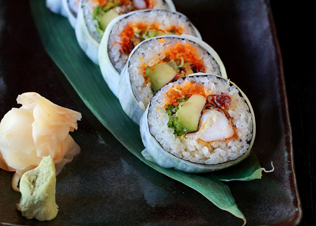News
Behind the sushi counter at Nobu
Wednesday, March 27th, 2013
I arrive on a seemingly quiet Tuesday afternoon and step through the doors of the Nobu kitchen at One&Only Cape Town to discover a hive of ordered activity. Steam is hissing from hot pots, people are quietly chopping and prepping, and the counters are spotless, stainless and stark. It seems head chef Fred Faucheux and newly appointed sushi chef Keisuke ‘Kekke’ Itoh run a tight ship.
I’m here to meet Kekke-san, as his assistant Usman Khan respectfully refers to him, the master of sushi at this high-profile hotel at the V&A Waterfront. I don’t know quite what I’m expecting – a drill sergeant wielding a big knife? – but smiling chef Kekke is thoroughly charming and a little shy. He leads me to the sushi counter that faces the dining room of expectant tables and chairs. The restaurant opens at 6pm, so I am in time to witness the final behind-the-scenes place-setting, chair-straightening and vacuuming that leaves the room impressively spic and span.
I am immediately distracted by my surroundings and busy myself photographing a handful of purple blossoms, stacks of glossy plates awaiting award-winning food (this branch of Nobuyuki 'Nobu' Matsuhisa’s Japanese restaurant empire was named a Top 10 restaurant in 2011), and all the pinkly glistening fish.
After getting my attention, Kekke explains that he’s going to show me how to make Nobu-style crab ceviche. He indicates a giant silver bowl filled with water and hundreds of floating potato strings that, as I later learn, have been finely sliced with a mandolin. (He laughs when I ask if he cut them by hand.)
I follow him through to the kitchen proper to watch him pour the strips into a huge pot and bring the water to the boil, before drenching them in a waiting ice bath to halt the cooking process. The ice cubes are discarded, the potato is drained, and enough of the starch has been removed to render the potato ready for its toppings. This is a lesson I learn quickly: never assume that even the simplest-seeming ingredients don’t have a complicated process behind the scenes.
Invited to taste the result, I am surprised to find no earthy taste of potato at all. The texture, too, is more like glass noodles. This makes it perfect to receive the fragrant flavours to come. After a squeeze of ‘spicy’ sauce containing chilli, garlic, soy sauce, vinegar and ponzu – I nod eagerly when asked if I like hot things – the potato is garnished with beautifully tender and delicate crab meat, scallions (rinsed thoroughly to rid them of their sharp onion taste), just a drop of sesame oil, a sprinkle of bright green chopped chive and ginger mix, fresh coriander, and a topping of crispy onions.
All these ingredients have been prepared in advance, and have their place in a neatly ordered, labelled and arranged series of trays and fridges. Every surface is fastidiously wiped after each step. Certainly, organisation is one of the secrets to a successful sushi kitchen. Usman tells me he sharpens the knives a few times a week, and every night before service he carefully washes and prepares the rolling mats, some of them with non-sticky clear wrap – deftly sliced from a colossal spool – to make rice-covered rolls.
Between sublime ceviche mouthfuls, I chat to chef Kekke and hear that it has always been his dream to come to Cape Town. With this as an ultimate destination in mind, Kekke agreed to leave the restaurant at which he was working in Malta for Nobu in the Bahamas, thinking that from there he could make a move to Cape Town next. He waited for a few years, but eventually his wish to come to the ‘motherland’ was granted on 18 January earlier this year.
Kekke adds some of his own flavour to the menu here, but most of the dishes are those created by world-famous Matsuhisa. When I ask about the absence of the usually ubiquitous sushi carousel, Kekke laughs and says that that version is not considered real sushi in in Japan. “’Spinning sushi’ is more of a takeaway thing!” Not that he turns his nose up at it, however. On his first trip back home he’s planning to head straight to one of these eateries, he reveals with a wistful grin.
The sushi chef hasn’t had all that much chance to explore Cape Town or authentic South African food yet, but so far he’s loved springbok – so much so that he might be tempted to work it into a dish. Nobu’s flagship dishes at the moment include the yellowtail sashimi with jalapeno, the black cod and the wagyu beef.
Before I leave, Kekke takes a little surprise out of the oven for me. Packed with wakame seaweed and baked in a layer of salt, a pearl of (farmed) abalone is uncovered, sliced and served on a bed of glossy bamboo leaves. No spices are added, no sauces drizzled for this understated treat. It’s pleasantly chewy and blissfully fresh, and showcases the true flavour of this delicacy in a way that I’ve never tasted before. The chef laughs that one of the kitchen staff mistakenly threw away the ‘liver’ of the abalone that he uses in a special sauce – that’s the South African way, he teases – but this dish is perfect in its simplicity. Which neatly sums up the Japanese way, if you ask me.
By Linda Scarborough








